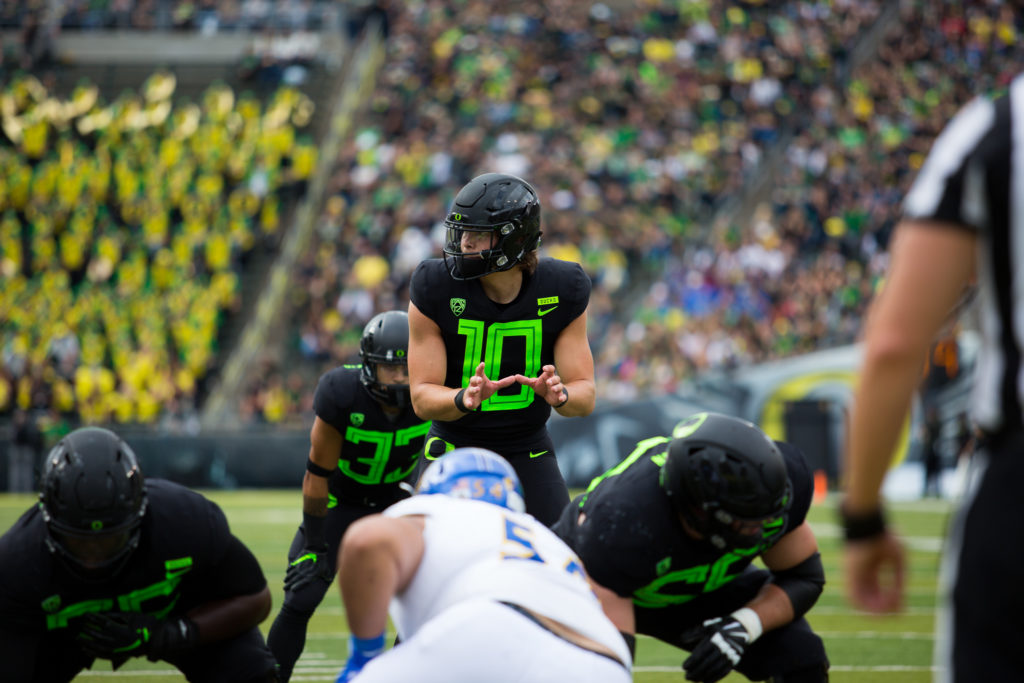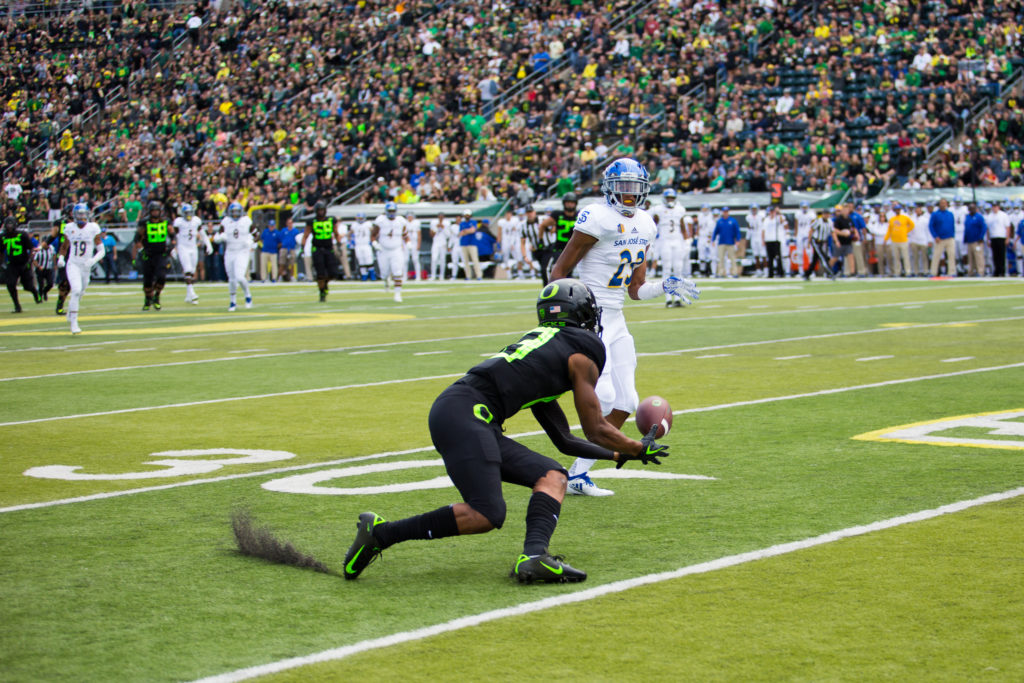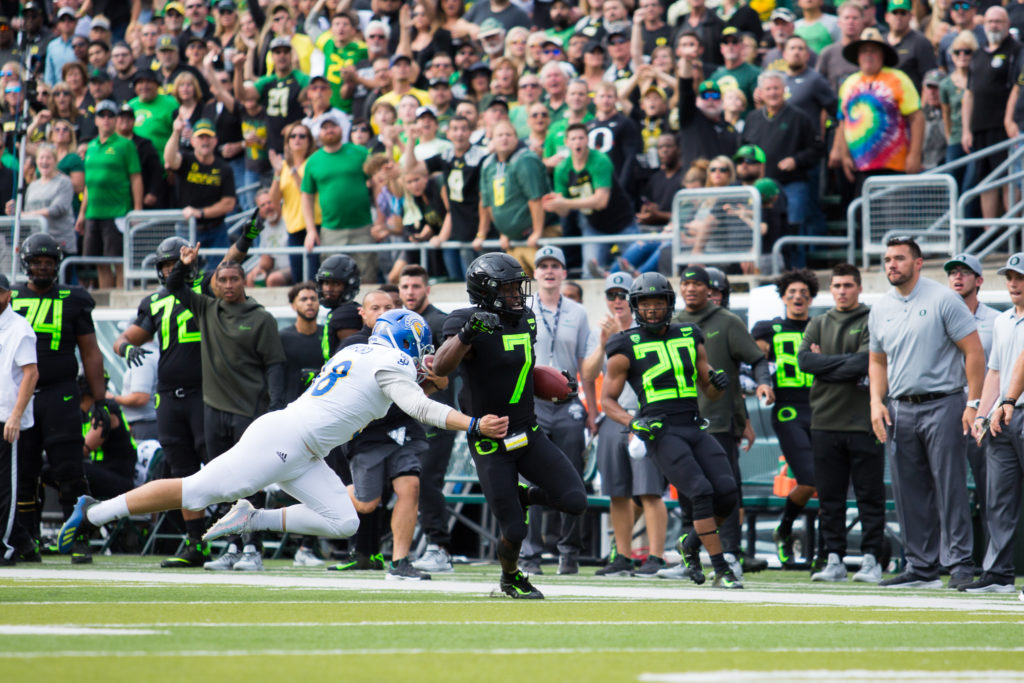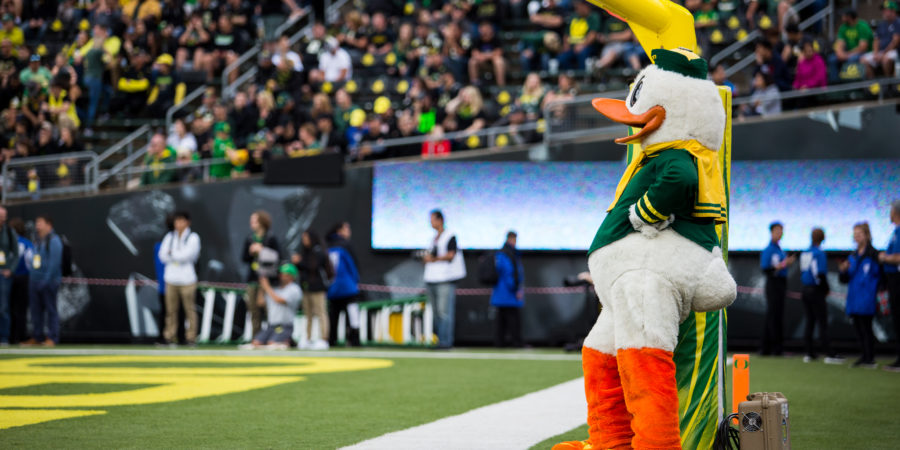There’s good news and bad news for Oregon coming out Saturday’s game versus San Jose State.
The good news: the Ducks got the win and seemed to stay relatively injury-free, moving to 3-0 following their 35-22 victory over the Spartans inside Autzen Stadium.
The bad news: it was undeniably Oregon’s worst performance of the young season, as inconsistent play and an apparent lack of general focus marred what was, on paper, supposed to be a complete dismantling of an inferior opponent.
With the Stanford Cardinal set to invade Eugene next Saturday, an introspective week for head coach Mario Cristobal and the Ducks lies ahead, as the win did very little to inspire confidence heading into their highly-anticipated Pac-12 opener.
Below, WFOD dissects the details stemming from Oregon’s lackluster victory over San Jose State.
1. The Oregon offensive line lost the battle at the line of scrimmage
There are plenty of places we could start in our attempt to summarize Saturday’s action, but starting in the trenches feels like a fitting jumping off point. In short, the Oregon offensive line was outworked and thusly outclassed by the San Jose State front seven. Yes, the Spartans boast a veteran defensive line anchored by seniors Boogie Roberts and Bryson Bridges, but given the veteran nature of Oregon’s offensive line, not to mention the considerable size advantage, it was a surprise to see arguably the strongest and deepest unit on the Oregon roster get pushed around. And that’s putting it nicely.
After averaging a healthy 5.7 yards per carry through their first two games, the Ducks were swarmed up front by the Spartans, who held Oregon to an anemic 2.7 yards per rush and 134 yards total on the ground. Throughout the offseason, Oregon’s offensive line was billed as a group that was among the best in the Pac-12, but it was a group missing in action and the root cause for many of Oregon’s issues on offense Saturday. Given the anticipated step up in competition that Oregon will receive next week, a repeat performance from this group will likely spell disaster for the Ducks.

2. Justin Herbert was woefully out of sync
In fairness to Herbert, Oregon’s troubles up front did little to help in terms of keeping the Ducks balanced with a proficient running game. With that said, when Herbert did have time to throw, he was inaccurate and unexpectedly unsettled in the pocket. Though he would throw for three touchdowns and eclipse the 300-yard passing mark for the first time this season, Herbert completed only 47 percent of his passes and was picked off twice after staring down his intended targets.
The junior from Eugene is still the heartbeat of this offense and absolutely essential to Oregon’s success this season, but his performance versus the San Jose State defense – who ranked as one of the nation’s worst in defending pass entering the day – revealed some flaws in his game. As Oregon prepares to face a talented Stanford secondary next week, Herbert will need to be much sharper if the Ducks have any hope of coming away with the victory.

3. Drops are STILL an issue
Despite being perhaps the biggest point of contention for Duck fans this season, dropped passes continue to be a major issue for Oregon’s wide receivers – particularly early in the game. Yes, Herbert was erratic in what was arguably his worst outing since the Ducks’ debacle versus Boise State in last year’s Las Vegas Bowl loss, but his pass catchers were once again an Achilles’ heel, as Dillon Mitchell, Tabari Hines, and Jaylon Redd each dropped catchable balls in the first half. Fortunately for Oregon, the lack of consistency out of the receiver group has yet to cost them dearly, but it will almost certainly be an issue at an inopportune time if not fixed before the start of conference play.
4. Is the Oregon offense allergic to an intermediate passing attack?
While we don’t have an official diagnosis there, it’s becoming difficult to argue otherwise. Through three games, Ducks offensive coordinator Marcus Arroyo has dialed up a healthy number of slow-developing pass plays that challenge opposing defenses deep down the field in attempt to take advantage of the strong-armed Herbert. The issue, however, is that Oregon’s receivers have failed to get consistent separation from defenders, leading to a number of boom-or-bust plays through the air. Beyond that, the passing game has seemingly lacked variety through three games, oscillating almost exclusively between short dump-off passes to backs and tight ends and deep shots downfield. In a game where a short-to-intermediate passing attack could have perhaps helped Herbert settle into a rhythm, it was noticeably absent once again. Perhaps Arroyo and the Ducks’ offensive brain trust are purposefully limiting the playbook so as to not give too much away before conference play begins, but the lack of diversity is beginning to raise eyebrows.

5. Amadi, Hollins, and Holland lead the way on defense
Though the offense mostly struggled their way through Saturday’s uninspired victory over San Jose State, the Oregon defense once again showed why they may just be this team’s most reliable overall unit. In defending the run, the Ducks were masterful, holding the Spartans to 29 yards on 28 carries. Leading the charge for the Ducks was senior safety Ugo Amadi, who finished with eight total tackles and two pass breakups to go along with 100 yards in punt returns in what was his most dominant performance as a Duck to date. Justin Hollins and Jevon Holland were also exceptional on Saturday, as each notched an interception versus the Spartans. Hollins was particularly impactful, as not only did he tie Amadi for the team lead in tackles, but also added two tackles for loss, a sack, a pass breakup, and forced fumble.
HIGHLIGHT | I’ll take that. #GoDucks pic.twitter.com/9aIN190i4e
— Oregon Football (@oregonfootball) September 15, 2018
6. Penalties rear their ugly head
Through their first two games, the Ducks were mostly successful in avoiding costly penalties that absolutely plagued them last season. Against San Jose State, the penalties reappeared, though not so much in frequency, but in the way they nullified potential momentum shifting plays. Oregon finished the game with six penalties for 59 yards, though one personal foul penalty by Austin Faoliu erased a second Jevon Holland interception, while a holding penalty denied Tony Brooks-James of a 96-yard kickoff return for a touchdown. On a day in which in the Ducks looked more than fallible, it only made sense that penalties were a thorn their side.
News and notes:
- It’s official: ESPN’s College GameDay is headed to Eugene for the Ducks’ conference opener vs. Stanford next Saturday. It will be GameDay’s first appearance in Eugene since 2014, when Oregon hosted Michigan State.
- On the injury front, true freshman offensive lineman Penei Sewell suffered a sprained ankle late versus San Jose State, though Cristobal seemed to indicate in his postgame press conference that it wasn’t anything to be concerned about long-term. Cristobal also mentioned that wide receiver Brenden Schooler was being evaluated for a concussion. Before the game, sophomore quarterback Braxton Burmeister was seen on crutches. Following the game, Cristobal said that Burmeister underwent a minor knee procedure and should be healthy enough to return in two weeks. Cristobal also said that he expects sophomore kicker Adam Stack (leg) to return next week vs. Stanford.
- The victory over San Jose State extended Oregon’s home non-conference win streak to 23 games
- With Jacob Breeland’s touchdown Saturday afternoon, 13 different offensive players have scored a touchdown for the Ducks this season. Defensively, the Ducks are holding opponents to 2.2 yards per carry.
- Justin Herbert passed Akili Smith for seventh-most touchdown passes in a career at Oregon with 46
- Justin Hollins has now recorded a sack in all three games this season and four straight games dating back to the Las Vegas Bowl last season. He also extended his streak of consecutive games with a tackle for loss to seven.
- Cyrus Habibi-Likio ran for a touchdown for the third straight game and has four scores on five carries this season


Great recap!
The penalties were annoying but a couple also questionable (including a pass interference from Lenoir and the holding from the kick return). Even still, 6 penalties for 60 yards isn’t awful within a terrible performance.
This game was three random plays away from being 49-15. We lost the kick return for a TD, gave up a kick return for a TD (basically), and Herbert threw an awful pick in the end zone. So on a day when our O-line underperformed, our star QB wasn’t sharp, our receivers dropped passes, and penalties plagued momentum, we theoritically beat them by 34. If we turn these things around, we should be fine during pac 12 play.